|
|
 |
|
Calanoida ( Order ) |
|
|
|
Clausocalanoidea ( Superfamily ) |
|
|
|
Stephidae ( Family ) |
|
|
|
Stephos ( Genus ) |
|
|
| |
Stephos kurilensis Kos, 1972 (F,M) | |
| | | | | | | Ref.: | | | Kos, 1972 a (1973) (p.113, figs.F,M); Bradford-Grieve, 1999 a (p.25, Table1: Rem.); Kos, 2016 (p.13, figs.F, M, Rem.) | 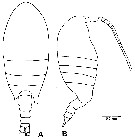 issued from : M.S. Kos in Crustaceana, 1972, 23 (2). [p.114, Fig.1]. Female (Izmena bay, Kunashir Island): A-B, habitus (dorsal and lateral, respectively). Nota: Head and Th1 fused, 4th and 5th fused. Last thoracic segment asymmetrical, the right side more elongated, extending to the middle of the genital segment; the distal corner of the segment widely rounded in lateral view. Rostal prominence low, without filaments. Urasome 4-segmented, its length is less than 1/3 of the cephalothorax. Genital segment swollen on the left lateral margin. Caudal rami symmetrical, with 4 strong and 1 small setae, the innermost seta arises separately from the distal margin of the ramus.
|
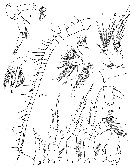 issued from : M.S. Kos in Crustaceana, 1972, 23 (2). [p.115, Fig.2]. Female: A, A1; B, A2; C, Md; D, Mx1; E, Mx2; F, Mxp; G-J, P1 to P4; K, P5. Nota: A1 symmetrical, 24-segmented, reaching almost the proximal margin of the genital segment. A2 with protopod 2-segmented; exopod longer than the endopod; exopod 5-segmented with 3 terminal setae and 6 setae along the inner edge; endopod 2-segmentd, last segment with 6 terminal setae. Denticulate orocess of Md with 9 teeth; basipod with 4 strong setae along the inner edge; exopod 4-segmented with 6 setae; endopod 2-segmented, its 1st segment with a few setae, 2nd segment with 8 terminal setae. P5 symmetrical, 3-segmented; terminal segment short and broad basally, its slightly narrows distally, the external distal edge is strongly serrate, at its base it carries a short, thick, strongly serrate process, which tapers apically.
|
 issued from : M.S. Kos in Crustaceana, 1972, 23 (2). [p.116, Fig.3]. Male: A-B, habitus (dorsal and lateral, respectively); C, P5. Nota: Mouth parts and swimming legs as in female. Right leg of P5 long and slender, 4-segmented, 3th segment very slender and long, it bears 1 small outside spine; last segment claw-like and carries 2 processes on the inner proximal margin; left leg 5-segmented, the penultimate segment is the largest and the most massive, it has a complex cristate formation; the terminal segment carries a number of plates and cristate formations in a complex arrangement.
|
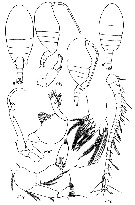 Issued from : M.S. Kos in Zoological Institut RAS, St. Petersburg, 2016, 179. [p.20, Fig.5]. Stephos kurilensis female and male.
|
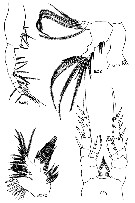 Issued from : M.S. Kos in Zoological Institut RAS, St. Petersburg, 2016, 179. [p.21, Fig.6]. Stephos kurilensis female. Note the teeth of the edge of Md and P2.
|
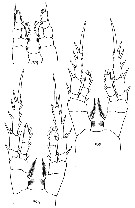 Issued from : M.S. Kos in Zoological Institut RAS, St. Petersburg, 2016, 179. [p.22, Fig.7]. Stephos kurilensis female: P1, P2 and P4.
| | | | | NZ: | 1 | | |
|
Distribution map of Stephos kurilensis by geographical zones
|
| | | | Loc: | | | NW Pacif. (Kuril Islands) | | | | N: | 1 | | | | Lg.: | | | (556) F: 1,42-1,26; M: 1,35-1,23; {F: 1,26-1,42; M: 1,23-1,35} | | | | Rem.: | above the Zostera belt (depth 10-16 m).
After Bradford-Grieve (1999 a, p.25) this species belongs to type III (see Genus Stephos). | | | Last update : 08/02/2019 | |
|
|
 Any use of this site for a publication will be mentioned with the following reference : Any use of this site for a publication will be mentioned with the following reference :
Razouls C., Desreumaux N., Kouwenberg J. and de Bovée F., 2005-2025. - Biodiversity of Marine Planktonic Copepods (morphology, geographical distribution and biological data). Sorbonne University, CNRS. Available at http://copepodes.obs-banyuls.fr/en [Accessed January 05, 2026] © copyright 2005-2025 Sorbonne University, CNRS
|
|
 |
 |









